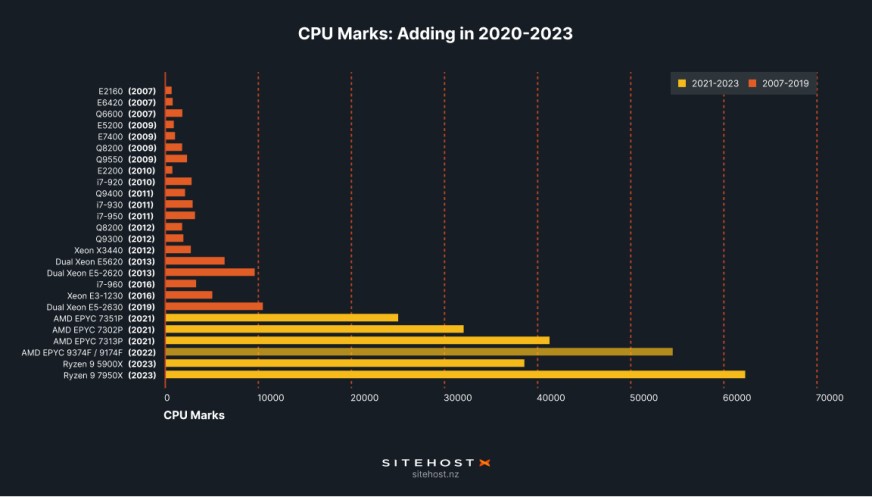When you think about the evolution of technology, you don’t often think about circular patterns. After all, progress is an arrow, right?
But an interesting trend in corporate and business computing is showing how, sometimes, the old ways can be new again. A growing number of happy companies and CTOs are “repatriating” workloads from the cloud (which, let’s be honest, usually means AWS).
Sometimes it’s a complete retreat to Dedicated Servers or VPS, and other times it's a move to a hybrid architecture. The hybrid option splits workloads between cloud services and bare metal, whichever is more efficient in each case. However it looks, we’re talking about a move away from cloud-based services and onto actual servers instead.
Related articles:
Nick Hayman of Panel Quote on why Azure wasn’t the right idea
Profile: Dave Sparks of Sparks Interactive, on AWS costs, Drupal, and open source
Podcast: We asked NotebookLM to make quick work of the long Cloud Exit story
Promises and delivery
For more than a decade the general wisdom in the business world has been that “the cloud” is the place to be. Amazon, Microsoft, and other providers made some alluring promises - technical wizardry that will enable amazing things like endless scalability, a service-based world where you’ll never think about hardware again and, best of all, your share of the financial spoils as the magic of technology at scale makes everything faster and cheaper.
In a lot of cases, those gains have been harder to realise than expected. Cloud architecture and optimisation decisions never end. New services and options keep piling up, making choices harder (and more consequential if you want to backtrack later). New fees look more like revenue-gathering than anything else. On the financial side the cloud has definitely made a huge impact - but mostly to shareholders of companies like Amazon and Microsoft, rather than their customers.
Meanwhile the more straightforward option of just owning and operating machinery has gotten much, much better over time. In the years we've been offering Dedicated Servers, CPUs have literally gotten 100x better but no more expensive. The cost of storage space is down by 95% and the speed of hard drives is almost incomparably faster. It's not just Dedicated Servers - these same gains also make today's Virtual Servers a very different proposition compared to what was available even a few short years ago.
You can no longer assume that cloud services are your business's best bet. TechCrunch is calling it the “cloud backlash”, a strong label that researchers at 451 Alliance (part of S&P Global) quantified by surveying IT decision makers late last year.
451 Research found that, in the last 12 months, 54% of survey respondents said their organizations had moved workloads or data away from the public cloud. More often than not, organizations move applications and data together. [...] The vast majority (84%) of survey respondents whose organizations had moved workloads away from the public cloud transitioned it to infrastructure they manage.
37signals, makers of products including Basecamp and Hey, are a prime example. They’ve been very open about their departure from AWS and its effect on the bottom line. “We have left the cloud”, founder David Heinemeier Hansson wrote in June:
We spent about half a million dollars buying two pallets of servers... This hardware was more than adequate to run all the heritage services we brought home, together with HEY, and give our other Basecamp operations a hardware refresh. And it was less than a third the cost of what we predict we'll be saving EVERY YEAR!
No wonder that sharing our experience with this cloud exit has made a lot of companies think twice about the insane cloud rental bills they're incurring every month. Our collective cloud budget last year was $3.2m, and this was incredibly optimized, with long service commitments, scrupulous right-sizing and monitoring.
This came after Dropbox announced savings of over US$75M in 2018. Extrapolating from cases like these, Andreessen Horowitz estimated in 2021 that excessive cloud costs had a total impact of over US$500B on public companies.
As Andreessen Horowitz noted, every company is different and there are times when cloud services make financial sense. What they reckon is most important is recognising when the cloud is not the best option, and not being locked in when it’s time to leave.
Economic forces strong enough to move terrabytes
Sticking with Andreessen Horowitz’s analysis, if you’re scaling fast and you want to avoid upfront investment then the economics of cloud services are likely to make sense. When today’s costs can be justified by tomorrow’s (expected) profits, your bean-counters will see the need for expensive cloud services that are ready to grow with you.
But this logic comes straight from a Silicon Valley playbook that is being rewritten, fast. Things that worked in times of low interest rates don’t work anymore. Burning cash and chasing growth at any cost is out of fashion. In today's economy, the time to start paying your own way kicks in much earlier.
Once a business has a predictable baseload of compute, and/or its first lakeful of storage to manage, it’s time to redo the maths. Having full access to your own servers can be much more cost-effective, especially when you know you’ll get full use of them over time.
Speaking of doing maths, Spotify started something interesting in 2020. Cloud computing had become such a massive part of the company’s costs that they built a tool called Cost Insights so that “engineers can see the impact of their cloud usage (down to a product and resource level) and make optimizations wherever and whenever it makes sense”. On one hand, that’s a really clever idea. On the other, it shows that cloud optimisation is such a hard problem to solve that one of the world’s leading software makers has put it on their engineers’ shoulders.
We have had our own struggles with AWS cost optimisation, so Spotify's travails are unsurprising to us. When you are used to building first and optimising later, it's not easy to switch to optimising as you build.
Servers: The next big thing comes in four basic flavours
Where do workloads go when they leave the public cloud? The main options are:
Virtual Servers (VPS), which can replace all sorts of EC2 instances with a simple fixed price and offer impressive High Performance options.
Rented machines, like a Dedicated Server with a fixed monthly or annual cost. The CPUs that we’re offering today offer around 100x the performance of the first Dedicated Servers that we stocked, and the cost has hardly budged.
Servers that your company owns, colocated in a professionally-managed data centre. You find and fund the hardware that works for you, and we keep it cool and connected.
Architecture that offers some of the benefits of cloud services, but runs them on dedicated servers that offer a specific set of resources at a fixed cost. We call that Private Cloud.
If you think it might be time to compare these options, we’re always open to a confidential chat. You might be surprised how your cloud bill looks in light of our advice.
Main image by garten-gg on Pixabay.




